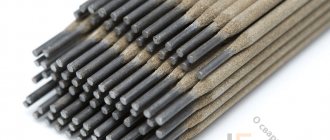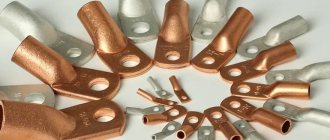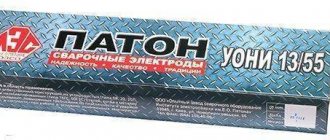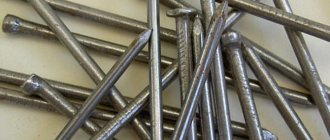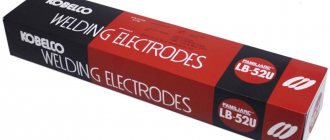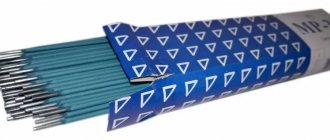Nails are one of the first things people began to make after mastering metal processing. Even today no construction can be completed without them. And here everything is clear: simplicity and reliability do their job. Although, in reality, nails turn out to be not so simple: they differ in design, holding capacity, purpose, and much more. We will talk about all this further.
Nails have evolved along with the technology for their manufacture. The historical predecessors of the modern nail are shown in the photo.
The pedigree of this fastener is usually traced back to Roman forged nails. Later, so-called cutting nails appeared; the manufacturing process was slightly optimized: they began to be cut from pre-prepared sheets of metal. However, nails continued to be quite expensive. This is well evidenced by the fact that buildings that had served their purpose were often burned to collect valuable fasteners from the ashes. It became widespread and cheap only after the development of rolling technology: in fact, a wire nail is the first rolled metal product. This manufacturing principle is still used today.
General description and types of nails
Finish nails are fasteners that have a small cylindrical head instead of a wide head. Thanks to this, they practically do not damage the surface of the finishing material and are invisible even when they are not hidden after work.
Depending on the coating, products are divided into several types:
- Black finishing. Such products do not have additional coating or are not protected from moisture, so they are not used when securing materials outdoors.
- Galvanized finishing nails. Such products are the most popular because they are quite cheap. The zinc layer prevents corrosion on the products, so they can be used in rooms with high humidity.
- Copper-plated. Due to their corrosion protection, such products can even be used when lining baths or when securing materials outdoors.
- Products coated with bronze. The disadvantage is more weight. It is also worth noting that nails are more expensive than, for example, galvanized ones.
- Finishing nails are brass-plated. Such products are used in rooms with high levels of humidity. They are less popular than other types of such products, as they have a high cost.
- Chrome plated. Such products are often used to create furniture. They are smaller in size.
When driven into wood, these fasteners are completely immersed in the wood and become invisible. If necessary, you can cover them with a composition that resembles wood in color.
The minimum length of finishing nails is approximately 35 mm. If desired, you can purchase fasteners up to 100 mm long. The heads of such products are not much wider than the rod, so after they are sunk into the wood, the fastening element is practically invisible.
Product prices
The cost of hardware depends on the coating and size. For example, one kilogram of galvanized finishing nails will cost 150 rubles. Copper-plated nails in the same quantity cost about 300 rubles.
Nails coated with bronze will be cheaper, on average 250 rubles. Brass-plated nails in the amount of 170 pieces will cost at least 600 rubles.
Finishing nails are considered the most practical and convenient fastening of interior finishing material. They reliably connect the elements and are practically invisible, which significantly improves the aesthetic appearance of the room.
Features of installation using finishing nails
Using finishing nails does not cause any difficulties even for an inexperienced person. This is due to the fact that a light hammer is used to secure the materials, and driving is done almost effortlessly.
Before starting work on securing platbands or other finishing nails, it is necessary to take into account the following features of the process:
- In order not to damage the surface when driving the fastener, you need to drill a blind hole in it with a drill with a diameter of no more than 1.5 mm. This should be done when attaching MDF or veneered MDF.
- It is better to hammer the product into the edge of the casing or into the groove, since when located in the middle it is more noticeable.
- In order not to spoil the surface, you need to recess the caps using a metal hammer. This device looks like a steel rod and has a small indentation at the narrow end that prevents it from coming off the nail.
- To speed up the work process, you can use a pneumatic gun, which also helps maintain the integrity of the surface.
What sizes of nails are there?
We don’t want to disturb anyone’s patriotic feelings, but in the Western system, the gradation of fastener sizes is simpler and more logical. The starting point is an inch nail (designated 2d). Then each step of dimension (3d, 4d, etc.) is an increase in length by a quarter of an inch. Naturally, they also have nails smaller than one inch.
The GOST system is less logical. For example, a construction nail* (the most popular type of fastener) has the following gradation of sizes:
Length: 16, 20, 25, 32, 40, 50, 60, 70, 80, 90, 100, 120, 150, 200, 250, 260, 300, 310 mm
Diameter: 1.2, 1.4, 1.6, 1.8, 2.0, 2.5, 3.0, 3.5, 4.0, 5.0, 6.0, 7.6, 8.0 and 8.8 mm
As you can see, the gradation of diameters is narrower, so nails of different lengths can have the same thickness.
*GOST 4028-63
How to hide hats
Despite the small diameter of the heads, finishing nails can be quite noticeable if they are located at eye level. To completely hide the fasteners, you can use:
- Furniture wax. It is enough to drown the fasteners in the wood using a hammer and cover the recess with wax.
- Circles. To close the caps, many people use special circles that are glued to the surface of the wood. Among the presented products, you can choose exactly those that match the color and structure of the wood.
- Putty of a suitable color. This material also effectively hides the caps and does not stand out against the background of the wood.
In most cases, it is enough to just recess the cap deeper into the material so that it is not noticeable.
Special tools
To recess the fastener heads without damaging the finishing material, you can use a hammer - a cone-shaped metal rod with a thinned end (the one that will come into contact with the hardware). There are two types:
- With a recess for the heads - to prevent the hammer from slipping;
- With grooved depth - for secure fixation of nails with grooves.
The second side of the tool must be struck with a hammer. They don't require much experience to use. Just bring it to the head and drive it a couple of millimeters into the finishing materials.
A pneumatic nail gun is convenient and effective for fixing finishing nails. Nailers (nailers) are selected according to the size of the hardware.
Different Ways to Use Nails
Finish nails are driven in several ways, depending on the type of material being fastened and its location. If, for example, the lining is being secured, the products are hammered in so that they are not visible. This is possible due to the structure of the finishing material. The finishing nails are driven at a 45-degree angle into the groove, which is then hidden by the lip of the next trim piece.
If door slopes are secured, the products are driven into the edge of the finishing material or into a recess, if there is one on it. In most cases, the nails are not visible, even if you hammer them in without a hammer. But it is better to use this tool so that the caps of the fasteners are completely immersed in the material.
When fixing parquet to the floor, the finishing nails are driven into the groove, so they are not visible after the work has been done. It is necessary to hide these fastening materials only when attaching slats to wooden frames or when finishing doorways.
What steel are nails made from?
Basically, nails are made from low-carbon, thermally untreated general-purpose wire (popularly called black steel). The fasteners themselves come in two types: without additional processing and with a thin layer of zinc coating applied to the surface.
When unprotected, black steel is vulnerable to corrosion, so for structures used outdoors, it is better to select nails with a protective coating. This is especially true for nails of small sizes, because... they lose their holding power more quickly when they rust. We will talk in more detail about steel grades for different types of fasteners as we go along.
How to determine the required length
When choosing finishing nails, you should think not only about making the fasteners invisible, but also about their reliability. If they are not long enough, they may not support the weight of the finishing material.
The length of the fastener should be twice the width of the material being nailed. If it is smaller, the finishing element will not be secured securely. If nails are needed for assembling furniture, as a rule, products no longer than 3 cm are purchased. Typically, these fasteners are included in the kit.
How long should the nails be?
When it is necessary to knock down a wooden structure, few people dive into strength materials and engage in “engineering” calculations. This is not necessary. A simple diagram helps you avoid making mistakes when choosing nails for structures with different loads.
- For optimal peel resistance, the length of the nail should be three times the thickness of the board being nailed.
- For acceptable shear strength, the nail needs to penetrate the part being driven to a length of at least six times its diameter.
Specifications
The characteristics of the finishing nail are regulated by GOST 7811-7035. More precisely, a product is produced according to a drawing with this name, while its other parameters are regulated by specifications.
According to GOST, finishing nails are made from steel wire that has not undergone heat treatment - unhardened. The requirements for dimensional accuracy are quite standard:
- the maximum possible errors in the length and diameter of the product are regulated by GOST 3282-74;
- deviations in alignment are determined by the size of the section, for example: 0.2 mm with a nail rod diameter of 1.3 mm;
- the height of the cap should be equal to the diameter of the rod, the amount of deviation depends on the size of the cross-section;
- sharpening angle - tip, should not exceed 40 degrees;
- the deflection of the rod is determined by the length of the product, for example: 0.7 mm with a total length of 60 mm.
To check quality, samples are randomly selected and laboratory tested. A batch of products is considered acceptable if the volume of nails that do not correspond to standard sizes does not exceed 0.5%.
Read below about installation and prices for black, galvanized, copper, brass and other finishing nails for fastening lining, imitation timber and other materials.
Advantages and disadvantages
When choosing nails for lining, you should consider what strengths and weaknesses this fastening material has.
Let's start with the plus:
- Light weight
. The fasteners will not load the structure. The weight of 1 thousand fasteners with a length of 20-50 mm is 350-800 grams; - Decorative effect.
Due to the fact that the cap is driven into the material, it remains almost invisible. This allows you not to disturb the appearance of the lining; - Corrosion resistance
. Relevant for all types except black nails.
But there are also certain disadvantages.
To be more precise, clapboard nails have two disadvantages:
- Dismantling without damage is impossible
. It is impossible to pick up the recessed small head with anything. The panel will probably be damaged; - Use of a puncher
. Without using a hammer, you won't be able to drown the head. An ordinary hammer or air gun is not enough. A combined approach is needed. Using 2 tools requires more time and care.
But judge for yourself how significant these shortcomings are. I think if you know how to nail it correctly, these disadvantages can be avoided in practice.
An alternative to nails - clamps
Not only clapboard nails can be used during installation. There is also such a fastener as a clamp.
Kleimers are metal plates that have holes for nails/staples, as well as a tongue of a given shape. The latter allows you to hold the lining by its groove.
Clamps or clamps are suitable for installing lining and ventilated facade systems, including PVC panels, MDF panels, chipboards, wooden block houses, etc. The fasteners are reliable, ensuring hidden installation of finishing.
Claimers are good because high-carbon steel is used for their production. Then comes the galvanized coating on top. This allows you to withstand severe loads from water, moisture, temperature, etc. Plus, due to the special design, the fasteners are invisible, but at the same time strong and reliable. Here it is important to choose the correct size of the clamp.

